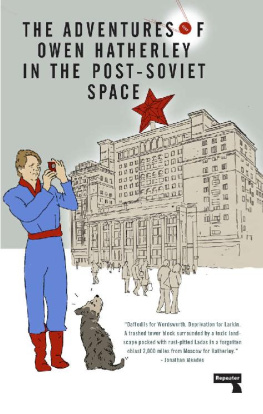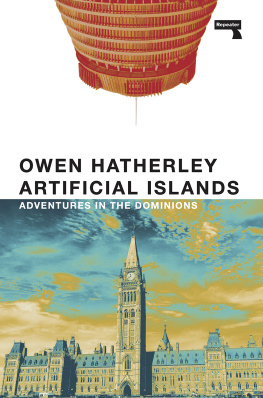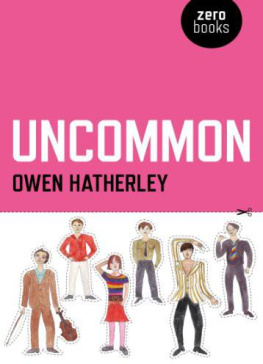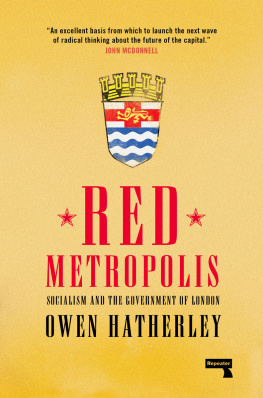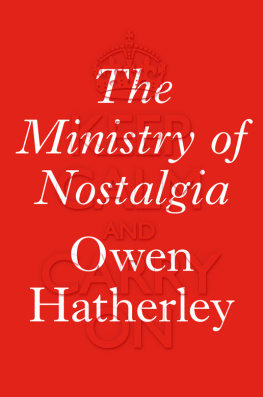Owen Hatherley - The Adventures of Owen Hatherley in the Post-Soviet Space
Here you can read online Owen Hatherley - The Adventures of Owen Hatherley in the Post-Soviet Space full text of the book (entire story) in english for free. Download pdf and epub, get meaning, cover and reviews about this ebook. year: 2018, publisher: Repeater, genre: Art. Description of the work, (preface) as well as reviews are available. Best literature library LitArk.com created for fans of good reading and offers a wide selection of genres:
Romance novel
Science fiction
Adventure
Detective
Science
History
Home and family
Prose
Art
Politics
Computer
Non-fiction
Religion
Business
Children
Humor
Choose a favorite category and find really read worthwhile books. Enjoy immersion in the world of imagination, feel the emotions of the characters or learn something new for yourself, make an fascinating discovery.
- Book:The Adventures of Owen Hatherley in the Post-Soviet Space
- Author:
- Publisher:Repeater
- Genre:
- Year:2018
- Rating:5 / 5
- Favourites:Add to favourites
- Your mark:
- 100
- 1
- 2
- 3
- 4
- 5
The Adventures of Owen Hatherley in the Post-Soviet Space: summary, description and annotation
We offer to read an annotation, description, summary or preface (depends on what the author of the book "The Adventures of Owen Hatherley in the Post-Soviet Space" wrote himself). If you haven't found the necessary information about the book — write in the comments, we will try to find it.
The Adventures of Owen Hatherley in the Post-Soviet Space — read online for free the complete book (whole text) full work
Below is the text of the book, divided by pages. System saving the place of the last page read, allows you to conveniently read the book "The Adventures of Owen Hatherley in the Post-Soviet Space" online for free, without having to search again every time where you left off. Put a bookmark, and you can go to the page where you finished reading at any time.
Font size:
Interval:
Bookmark:
The
ADVENTURES
of
OWEN HATHERLEY
in the
POST-SOVIET
SPACE
The
ADVENTURES
of
OWEN HATHERLEY
in the
POST-SOVIET
SPACE
by
OWEN HATHERLEY

CONTENTS
A Short Introduction
Microcosmos: Slavutych
Part One: The Western Periphery
Forgotten Capital: Kaunas
A Guidebook of Revolutionary Relics: Kuldga
A Tour with the City Architect: Ventspils
Nuclear Model Village: Sillame
The Cradle of Three Revolutions: St Petersburg
Part Two: Debatable Lands
Art and Revolution: Kyiv
Oligarchy in Rocket City: Dnipro
The End of Communism in Eastern Ukraine: Zaporizhia
Streets of Crocodiles: Chiinu
Part Three: The Centre
Where the Gauges Change: Brest
Time, Backward! Minsk
Life in the Twenty-First Century: Moscow
A Week in the Kremlin: Nizhny Novgorod
The Architecture of Sovereignty: Kazan
Constructivist Capital: Yekaterinburg
Part Four: The Eastern Periphery
Brand Georgia: Kutaisi
An Exhibition of Achievements: Tbilisi
From the Purges to Paradise: Sevan Writers Resort
Mysterious Cities of Pink and Gold: Yerevan
The Green Friends of Mankind: Almaty
A City of the Future: Astana
Where Our Tomorrow is Already Yesterday: Bishkek
Notes
Acknowledgements
The everyday routes go past houses which have been bombed in different ways. There are sections of houses which keep reminding you of Meyerholds theatre sets. There are sections of small multi-coloured rooms with the little round stove still intact, painted the same colour as the wall, or an intact door, sometimes ajar. Grim stage-set doors, carefully made and leading nowhere. The house sections illustrate the storeys, the thin layers of floor and ceiling. You begin to realise with astonishment that as you sit at home in your room you are suspended in space, with other people similarly suspended above your head and below your feet. You know about this of course, youve heard furniture being moved about upstairs, even wood being chopped. But all that is abstract, unpicturable, like the way we are borne along through space on a sphere rotating about its axis. Everybody feels as if their floor rests on some kind of soil, covered over with planking. Now the truth had been revealed in a dizzyingly graphic fashion. There were skeletal houses with preserved faades, shot through with darkness and depth. And the sky can be seen through the empty window sockets of the upper storeys. There were houses, especially small ones, whose beams and flooring had collapsed under their crumbling roofs. They hung at an angle and looked as if they were still sliding down, perpetually falling, like a waterfall.
A new attitude to houses developed. People began to talk about houses, think about houses. The accepted unit of the city became the apartment house, just as previously it had been the street, with its merged undifferentiated faades. Unobservant people suddenly saw what constituted their city. It was made up of discrete areas of incomparable Leningrad beauty, out of astonishing complexes of stone and sky, water and foliage, and for the rest, apartment houses of the second half of the nineteenth century, with a certain trace of pre-revolutionary modern and boxes dating from the first years of the revolution. The wretched architecture of the second half of the last century, with its fear of line and plane, the flat surface and the unfilled space, which prompted it to cram every unoccupied space with some sort of stucco nonsense. Now we saw those houses, shabby and bare, standing in damp and rusty streams of poor-quality paint. In grim autumn days it seemed that the rusty dankness was oozing out from inside them. They presaged nothing good.
Lydia Ginzburg, Notes of a Blockade Person
A SHORT INTRODUCTION
The book you are reading is a guide to cities in what was once the Union of Soviet Socialist Republics. It is intended to be useful both to visitors, for whom this will tell them things they do not know, and to curious citizens, who will find an interpretation of what they do already know, which they may or may not agree with. There are many books on Soviet architecture today, bridging a gap between academic history and Instagram, and they tend to be heavy on images, low on description and context. This one, as a guide, has somewhat different ambitions, in that I hope for it not to sit on a coffee table, but to actually be placed in peoples pockets as they walk around. Accordingly, my model for these is not photobooks or historical monographs but the series of foreign language Soviet city guides published in the 1970s and 1980s by Progress Publishers. You can often find these in second-hand bookshops, in both East and West. They are unusual objects, insofar as they are not particularly useful as conventional guidebooks.
There are driving and travel tips, which say nothing about the guards and checkpoints you might meet on the way. An abundance of goods fill the pages local wines, fruits, sweetmeats, along with the buildings and the folk costumes. Maps are beautifully illustrated with schematic drawings of the important buildings and monuments, but are not to scale, so that you cant really use them to get around anywhere, even before so many of the street names were changed after 1989. Looking at these books Ive accumulated a minor collection you get some sense of the extreme geographic scope of the Soviet Union, the last Empire, as the Ukrainian historian Serhii Plokhy calls it (the USA might have something to say about that but certainly the last contiguous land Empire). Like all empires it had a centre Moscow, of course and a periphery, although the ways in which the two related to each other bears little resemblance to the way the European transcontinental empires worked. Money and investment most often flowed from the centre out to the periphery, whereas high culture (and, crucially for this book, architectural ideas) often flowed from periphery to centre. The guides to this empire encompass a geographical territory far larger than Europe, but whether youre in Lake Baikal near Mongolia, in Vladivostok a days sea voyage from Japan, in Central Asia on the borders of Afghanistan, in the Caucasus wedged between Turkey and Iran, or in Estonia, a short ferry ride from Helsinki, the story is always basically the same. First, there is a section on the historical development and monuments of the city in question, and this is relatively impartial. Then you hear about how the city was incorporated into Russia something that is usually considered a progressive move, despite the reactionary nature of Tsarism. You are then told about how it participated in the 1905 Revolution, then in the 1917 one. You are regaled with stories of the years of socialist construction (or of bourgeois degeneration, in the Baltics), then of the heroic efforts of the local populace in the Great Patriotic War. We end with a present in which your city has a prominent place in the socialist family of nations, and is building up the productive forces for the eventual transition to Communism.
This linear progression from great ancient history to the bad days to the optimistic present of transition resembles that found in the guidebooks you can find in any airport bookshop. The historical part is much the same, and the participation in revolution is shifted into the age-old struggle for national independence, which stretches usually from sometime in the Middle Ages (earlier, in the Caucasus) to its final achievement in the 1990s, and the eventual transition to capitalism (never quite satisfactorily achieved, it seems, but always
Next pageFont size:
Interval:
Bookmark:
Similar books «The Adventures of Owen Hatherley in the Post-Soviet Space»
Look at similar books to The Adventures of Owen Hatherley in the Post-Soviet Space. We have selected literature similar in name and meaning in the hope of providing readers with more options to find new, interesting, not yet read works.
Discussion, reviews of the book The Adventures of Owen Hatherley in the Post-Soviet Space and just readers' own opinions. Leave your comments, write what you think about the work, its meaning or the main characters. Specify what exactly you liked and what you didn't like, and why you think so.

